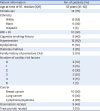INTRODUCTION
METHODS
Patient cohort
 | Figure 1Comparison of 3D-RT plan CT with post-RT CAC score using CAC-DRS method. Cardiac risk factors and coronary radiation dose volumes measurements might play a role in development of atherosclerosis. 3D: 3-dimensional, CAC: coronary artery calcium, CT: computed tomography, DRS: data and reporting system, RT: radiation therapy. |
CAC scan acquisition
Coronary artery calcium score quantification
CAC-DRS categories
1. CAC-DRS V0 = no coronary calcifications seen
2. CAC-DRS V1 = mild coronary calcifications
3. CAC-DRS V2 = moderate coronary calcifications
4. CAC-DRS V3 = severe coronary calcifications
Pre-RT coronary artery calcification assessments
Radiation dosimetry
Cardiac risk factors and dosimetric parameters
Statistical analyses
RESULTS
Patient characteristics
Table 1
Patient information

Pre-RT calcification assessments
Comparison between pre-RT calcification and post-RT calcification
 | Figure 2Changes in CAC-DRS categories in subjects (n = 20) before and after RT. Side to side comparison of changes in CAC-DRS in treatment plan (before RT) with calcium score scans (after RT). CAC: coronary artery calcium, DRS: data and reporting system, RT: radiation therapy. |
 | Figure 3Axial slice from CCT scans and 3-dimensional RT plans demonstrate regional association between radiation dose and coronary calcification. (A) RT to left breast and regional lymph nodes was delivered 1 year before CCT in (B). Prescription dose was 50 Gy. This patient had history of hypertension and dyslipidemia. (B) CCT demonstrating calcification of LAD. LAD CAC score was 46.55. (C) Chemoradiation therapy was administered for non-small cell lung cancer 10 years prior to CCT in (D). Prescription dose was 70 Gy. This patient had history of hypertension, dyslipidemia, and cigarette smoking. (D) CCT demonstrating calcification of LAD and left circumflex artery. LAD CAC score was 318.05, and left circumflex CAC score was 255.43. CAC: coronary artery calcium, CCT: cardiac computed tomography, LAD: left anterior descending artery, RT: radiation therapy. |
Radiation therapy information
Table 2
Coronary artery dosimetry and coronary artery calcium score

Coronary artery calcium scores
Correlation between radiation dosimetry and coronary artery calcium scores
Table 3
Correlations between coronary artery dosimetry and coronary artery calcium score

Correlation between covariates and coronary artery calcium scores
Table 4
Risk factors by status of coronary artery calcification

Statistical modeling
Table 5
Univariate generalized linear mixed models examine association between each risk factor and coronary artery calcification

Table 6
Multivariable logistic models and ROC analyses explore association of radiation dosimetric parameters and presence of diabetes with subsequent coronary artery calcification





 PDF
PDF ePub
ePub Citation
Citation Print
Print



 XML Download
XML Download